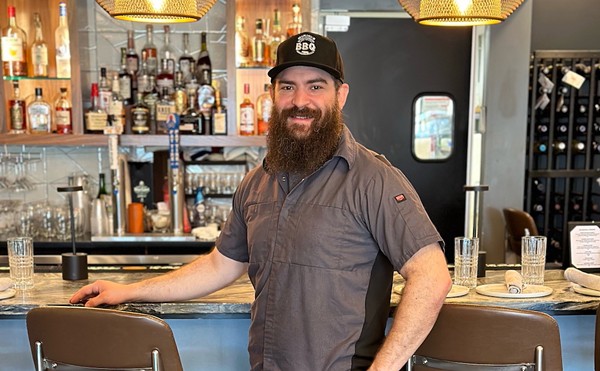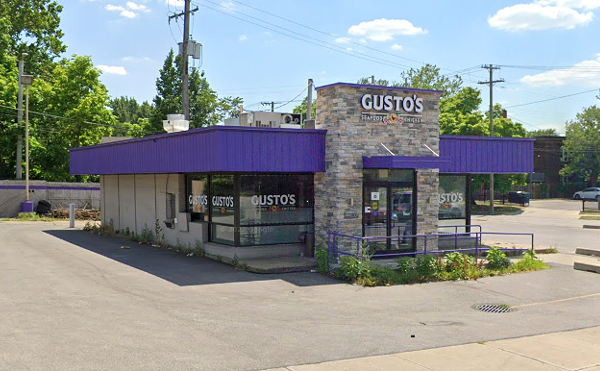If there is a more intimidating cuisine than Korean food, I have yet to stumble upon it. Walk into a place like Seoul Garden in Parma and you're immersed in an exotic setting where the sights, sounds, smells and customs of a typical restaurant are thrown for loop. Wide-rimmed cauldrons of lava-red stew gurgle away on tabletop burners. Large groups huddle around sizzling griddles draped with raw but cooking meat. Take a seat and the server sets down 1-2-3-4-5-6-7-8-9-10-11-12! tiny plates before you've ordered a thing. Crack open the menu and you're bombarded with foreign text, unpronounceable words and bewildering categories.
That's what makes dining here and at other Korean eateries such a thrill.
Seoul Garden opened in 2008 in the home of another Korean restaurant. A couple years ago the longtime owners retired to Korea, selling the operation to the folks who run Kim's Oriental Food, a Korean grocery on Superior. Through it all, however, the original chef has stayed put, explains Hannah Reszegi, longtime staffer and daughter of the previous owners.
While it is regarded by many admirers of the cuisine as the best around, Seoul Garden won't win any beauty awards. The buttoned-up exterior makes the place look perennially closed. Inside, '70s-era wood paneling, well-worn carpet and a drop ceiling conjure images of a suburban basement rec room. A large autographed poster of South Korean baseball player Shin-Soo Choo is pretty much the beginning and end of the decorations.
As with most ethnic adventures, it's helpful to spy on everybody else. Here, pretty much every table has a vessel of stew, or casserole, gurgling away on a tabletop burner. In fact, if you look around the room you'll spot scorched walls and window blinds from countless hot-pot close encounters. On the menu they're categorized as "jungol," and they come in varieties of spicy beef, spicy seafood, spicy lamb and a peculiar but popular version with Spam, hot dogs and instant ramen. At prices of $32 to $35, these options sound pricey, but they are celebratory feasts meant to be shared by two to four people.
"A lot of Koreans will share one of these stews, especially when they are drinking soju," says Reszegi.
A quicker and cheaper option — one more popular at lunch — is the soups, which simmer away for hours in the kitchen as opposed to in real time on the table. One of the tastiest is the yukgaejang ($9.95), a spicy, hearty, pungent brew with tender shredded beef, scallions, bean sprouts and glass noodles. This and many other Korean foods gets its blood-red hue from gochugaru, a red pepper powder that adds a steady and building heat presence. A bowl of steamed rice is served on the side, which can be added to the soup or eaten alone to temper the flames.
Reszegi acknowledges the intimidation factor experienced by some of her non-Korean customers. For them, she recommends bibimbop ($10.95), a sort of gateway drug for Korean food. Steamed rice is topped with shredded veggies, a smattering of ground beef and a raw egg. The whole affair is served in a screaming-hot stone bowl, or dolsot, which continues to heat and cook the ingredients as they are stirred and eaten. The best part is the crunchy rice bits stuck to the bottom of the bowl.
You don't get more celebratory than Korean barbecue. For $38 and $42 respectively, you'll get set up with a tabletop griddle and large platters of thin-sliced pork belly or beef brisket. The meat cooks up fast and is tucked into cool lettuce leaves, topped with red chili pepper paste, maybe some kimchi, and eaten out of hand. The other popular barbecue items, kalbi ($20.95) and bulgogi ($17.95), sliced short ribs or beef ribeye respectively, marinated in a sweet soy, sesame and garlic mixture, are grilled in the kitchen because of the marinade.
Most groups start their meals with pajeon, thick and crispy pancakes filled with veggies ($13.95) or seafood ($15.95). The wedges are dipped in a soy-vinegar sauce. If you've eaten these elsewhere, prepare to be stunned by the size. "Yeah, a lot of people who are used to the smaller ones at other Korean restaurants are shocked by how big ours are," notes Reszegi.
All meals here start with a wide, colorful array of housemade banchan, various raw, pickled or fermented veggies, tofu and even fish. These small plates offer a riot of flavors and textures, not all, admittedly, wholly enjoyable. The spread here is impressive: a dozen at dinner, nine at lunch, both including a fluffy egg custard steamed on the table. All of it free of charge.
Seoul Garden's menu is loaded with helpful pictures and descriptions, making meals here that much less intimidating. For best results, do as Reszegi suggests. "As long as you're adventurous, you'll have fun."









